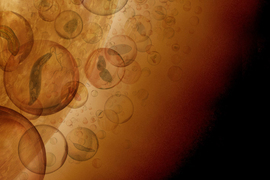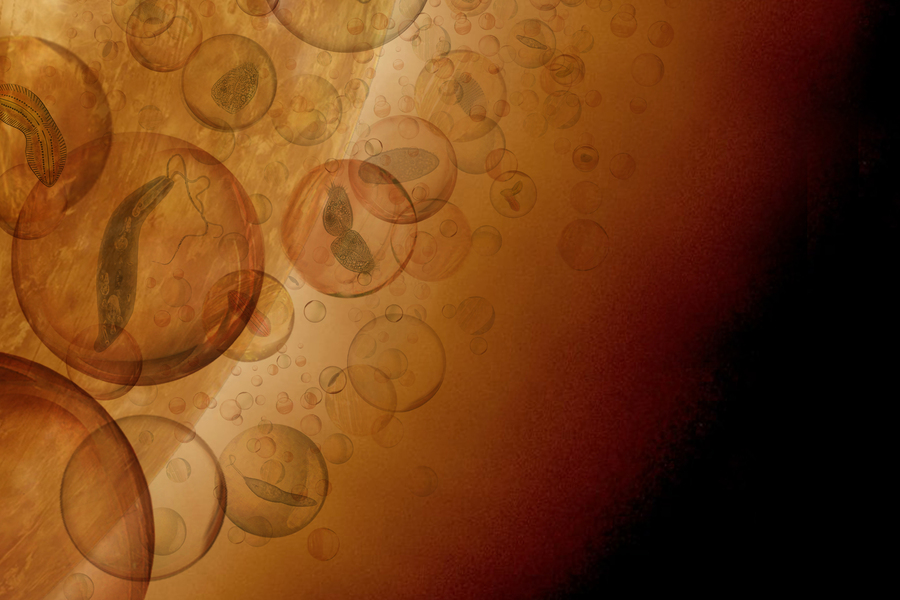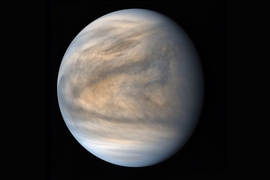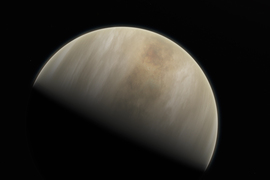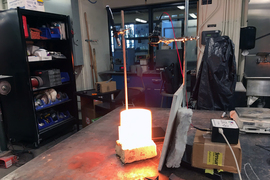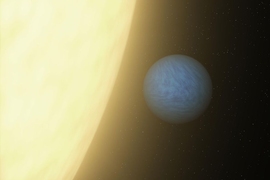It’s hard to imagine a more inhospitable world than our closest planetary neighbor. With an atmosphere thick with carbon dioxide, and a surface hot enough to melt lead, Venus is a scorched and suffocating wasteland where life as we know it could not survive. The planet’s clouds are similarly hostile, blanketing the planet in droplets of sulfuric acid caustic enough to burn a hole through human skin.
And yet, a new study supports the longstanding idea that if life exists, it might make a home in Venus’ clouds. The study’s authors, from MIT, Cardiff University, and Cambridge University, have identified a chemical pathway by which life could neutralize Venus’ acidic environment, creating a self-sustaining, habitable pocket in the clouds.
Within Venus’ atmosphere, scientists have long observed puzzling anomalies — chemical signatures that are hard to explain, such as small concentrations of oxygen and nonspherical particles unlike sulfuric acid’s round droplets. Perhaps most puzzling is the presence of ammonia, a gas that was tentatively detected in the 1970s, and that by all accounts should not be produced through any chemical process known on Venus.
In their new study, the researchers modeled a set of chemical processes to show that if ammonia is indeed present, the gas would set off a cascade of chemical reactions that would neutralize surrounding droplets of sulfuric acid and could also explain most of the anomalies observed in Venus’ clouds. As for the source of ammonia itself, the authors propose that the most plausible explanation is of biological origin, rather than a nonbiological source such as lightning or volcanic eruptions.
As they write in their study, the chemistry suggests that “life could be making its own environment on Venus.”
This tantalizing new hypothesis is testable, and the researchers provide a list of chemical signatures for future missions to measure in Venus’ clouds, to either confirm or contradict their idea.
“No life that we know of could survive in the Venus droplets,” says study co-author Sara Seager, the Class of 1941 Professor of Planetary Sciences in MIT’s Department of Earth, Atmospheric and Planetary Sciences (EAPS). “But the point is, maybe some life is there, and is modifying its environment so that it is livable.”
The study appears in the journal PNAS. Its co-authors include Janusz Petkowski, William Bains, and Paul Rimmer, who are affiliated with MIT, Cardiff University, and Cambridge University.
Life suspect
“Life on Venus” was a trending phrase last year, when scientists including Seager and her co-authors reported the detection of phosphine in the planet’s clouds. On Earth, phosphine is a gas that is produced mainly through biological interactions. The discovery of phosphine on Venus leaves room for the possibility of life. Since then, however, the discovery has been widely contested.
“The phosphine detection ended up becoming incredibly controversial,” Seager says. “But phosphine was like a gateway, and there’s been this resurgence in people studying Venus.”
Inspired to look more closely, Rimmer began combing through data from past missions to Venus. In these data, he identified anomalies, or chemical signatures, in the clouds that had gone unexplained for decades. In addition to the presence of oxygen and nonspherical particles, anomalies included unexpected levels of water vapor and sulfur dioxide.
Rimmer proposed the anomalies might be explained by dust. He argued that minerals, swept up from Venus’ surface and into the clouds, could interact with sulfuric acid to produce some, though not all, of the observed anomalies. He showed the chemistry checked out, but the physical requirements were unfeasible: A massive amount of dust would have to loft into the clouds to produce the observed anomalies.
Seager and her colleagues wondered if the anomalies could be explained by ammonia. In the 1970s, the gas was tentatively detected in the planet’s clouds by the Venera 8 and Pioneer Venus probes. The presence of ammonia, or NH3, was an unsolved mystery.
“Ammonia shouldn’t be on Venus,” Seager says. “It has hydrogen attached to it, and there’s very little hydrogen around. Any gas that doesn’t belong in the context of its environment is automatically suspicious for being made by life.”
Livable clouds
If the team were to assume that life was the source of ammonia, could this explain the other anomalies in Venus’ clouds? The researchers modeled a series of chemical processes in search of an answer.
They found that if life were producing ammonia in the most efficient way possible, the associated chemical reactions would naturally yield oxygen. Once present in the clouds, ammonia would dissolve in droplets of sulfuric acid, effectively neutralizing the acid to make the droplets relatively habitable. The introduction of ammonia into the droplets would transform their formerly round, liquid shape into more of a nonspherical, salt-like slurry. Once ammonia dissolved in sulfuric acid, the reaction would trigger any surrounding sulfur dioxide to dissolve as well.
The presence of ammonia then could indeed explain most of the major anomalies seen in Venus’ clouds. The researchers also show that sources such as lightning, volcanic eruptions, and even a meteorite strike could not chemically produce the amount of ammonia required to explain the anomalies. Life, however, might.
In fact, the team notes that there are life-forms on Earth — particuarly in our own stomachs — that produce ammonia to neutralize and make livable an otherwise highly acidic environment.
“There are very acidic environments on Earth where life does live, but it’s nothing like the environment on Venus — unless life is neutralizing some of those droplets,” Seager says.
Scientists may have a chance to check for the presence of ammonia, and signs of life, in the next several years with the Venus Life Finder Missions, a set of proposed privately funded missions, of which Seager is principal investigator, that plan to send spacecraft to Venus to measure its clouds for ammonia and other signatures of life.
“Venus has lingering, unexplained atmospheric anomalies that are incredible,” Seager says. “It leaves room for the possibility of life.”
This research was supported in part by the Simons Foundation, the Change Happens Foundation, and the Breakthrough Initiatives.
